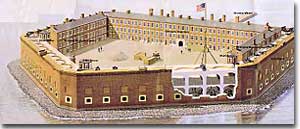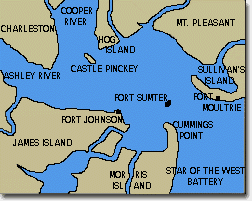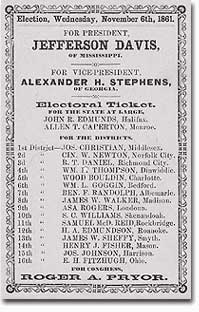33a. Fort Sumter

Confederate forces shelled Fort Sumter for three and a half days before Northern commander Major Robert Anderson surrendered. This image depicts Fort Sumter as it appeared in 1861.
It all began at Fort Sumter.
On December 20, 1860, South Carolina seceded from the Union. Five days later, 68 federal troops stationed in Charleston, South Carolina, withdrew to Fort Sumter, an island in Charleston Harbor. The North considered the fort to be the property of the United States government. The people of South Carolina believed it belonged to the new Confederacy. Four months later, the first engagement of the Civil War took place on this disputed soil.
The commander at Fort Sumter, Major Robert Anderson, was a former slave owner who was nevertheless unquestionably loyal to the Union. With 6,000 South Carolina militia ringing the harbor, Anderson and his soldiers were cut off from reinforcements and resupplies. In January 1861, as one the last acts of his administration, President James Buchanan sent 200 soldiers and supplies on an unarmed merchant vessel, Star of the West, to reinforce Anderson. It quickly departed when South Carolina artillery started firing on it.

Fort Sumter lies in the center of Charleston Harbor.
In February 1861, Jefferson Davis was inaugurated as the provisional president of the Confederate States of America, in Montgomery, Alabama. On March 4,1861, Abraham Lincoln took his oath of office as president of the Union in Washington, DC. The fate of Fort Sumter lay in the hands of these two leaders.
As weeks passed, pressure grew for Lincoln to take some action on Fort Sumter and to reunite the states. Lincoln thought of the Southern secession as "artificial." When Jefferson Davis sent a group of commissioners to Washington to negotiate for the transfer of Fort Sumter to South Carolina, they were promptly rebuffed.
Lincoln had a dilemma. Fort Sumter was running out of supplies, but an attack on the fort would appear as Northern aggression. States that still remained part of the Union (such as Virginia and North Carolina) might be driven into the secessionist camp. People at home and abroad might become sympathetic to the South. Yet Lincoln could not allow his troops to starve or surrender and risk showing considerable weakness.

Jefferson Davis was inaugurated provisional president of the Confederate States of America on February 18, 1861, and elected president of the CSA later that year.
At last he developed a plan. On April 6, Lincoln told the governor of South Carolina that he was going to send provisions to Fort Sumter. He would send no arms, troops, or ammunition — unless, of course, South Carolina attacked.
Now the dilemma sat with Jefferson Davis. Attacking Lincoln's resupply brigade would make the South the aggressive party. But he simply could not allow the fort to be resupplied. J.G. Gilchrist, a Southern newspaper writer, warned, "Unless you sprinkle the blood in the face of the people of Alabama, they will be back in the old Union in less than ten days."
Davis decided he had no choice but to order Anderson to surrender Sumter. Anderson refused.
The Civil War began at 4:30 a.m. on April 12, 1861, when Confederate artillery, under the command of General Pierre Gustave T. Beauregard, opened fire on Fort Sumter. Confederate batteries showered the fort with over 3,000 shells in a three-and-a-half day period. Anderson surrendered. Ironically, Beauregard had developed his military skills under Anderson's instruction at West Point. This was the first of countless relationships and families devastated in the Civil War. The fight was on.





